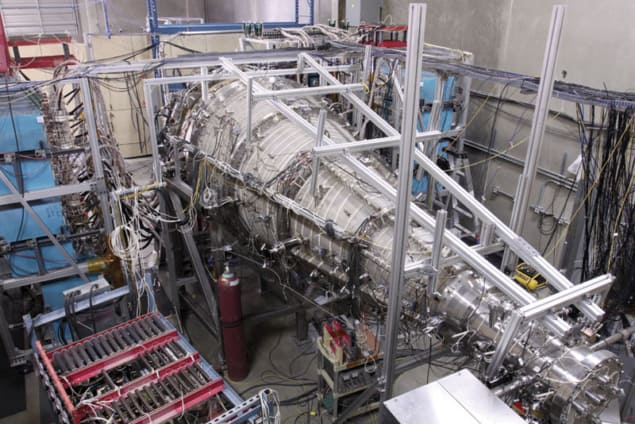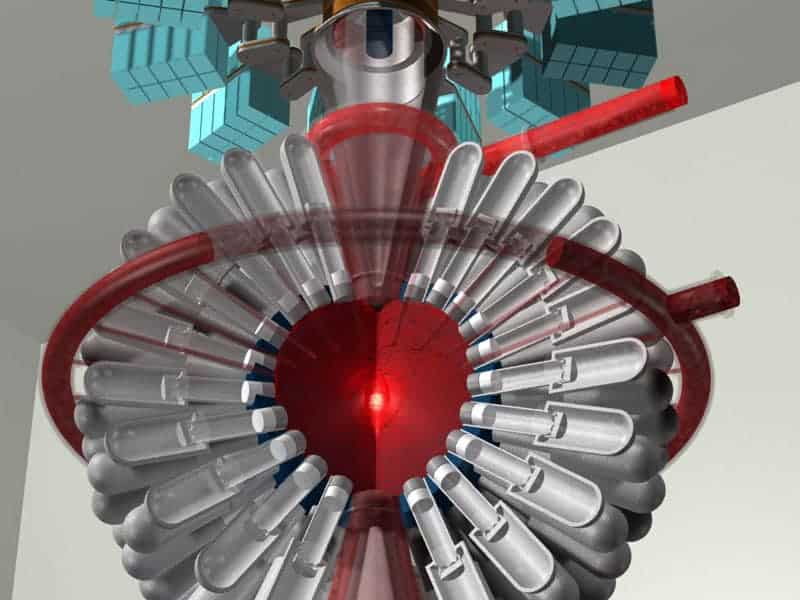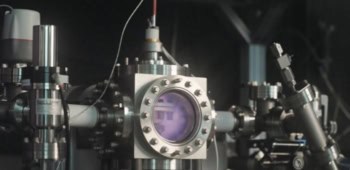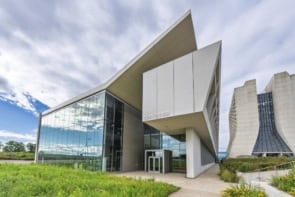A Canadian company is planning to build a prototype fusion demonstrator that would be a fraction of the cost of a standard fusion reactor, as Hamish Johnston reports

For most physicists, there are two possible paths to fusion energy. The first is magnetic-confinement fusion, which involves using magnetic fields to trap a plasma that is then heated until it is hot enough for hydrogen ions to fuse – about 150 million kelvin is what is typically needed. The other path is inertial confinement, whereby a dense target of hydrogen is compressed further by powerful lasers to initiate fusion.
While these approaches are technically very different, they have one thing in common – they are being developed in huge and expensive projects. Magnetic confinement is being led by the ITER facility that is currently being built in France at an estimated cost of €16bn, while the National Ignition Facility (NIF) in California is pioneering inertial confinement through the use of 192 giant lasers to blast a pea-sized target.
There are some physicists, however, who believe that there is a middle ground towards practical fusion – one that combines magnetic and inertial confinement yet can be achieved at a fraction of the cost of either. One such person is the Canadian physicist Michel Laberge, who co-founded the company General Fusion to commercialize a fusion technique called “magnetized target fusion”, or MTF. In 1990 Laberge received a PhD in plasma physics from the University of British Columbia, where he researched laser–plasma interactions. He then completed a postdoc in the same field at the Ecole Polytechnique in Paris and later at the National Research Council of Canada, where he used femtosecond lasers to study fast chemistry. This was followed by a nine-year spell developing technology for colour printing at the Vancouver-based firm Creo.
In 2002 Laberge and Creo colleague Doug Richardson left the company to create General Fusion, of which Laberge is now president and chief technology officer, and Richardson is the chief executive. Based in Burnaby, a suburb of Vancouver, the firm wants to build a $40m prototype reactor based on the principles of MTF. So far, the firm has raised more than $33m from a range of investors, including Amazon founder Jeff Bezos, the oil company Cenovus Energy and the Canadian government.
Hotter than the Sun
Like magnetic confinement, MTF begins with a plasma that is held in place by a magnetic field. This plasma would, however, be 1000 times denser than might be found in a reactor such as ITER – and therefore much less stable. But as long as the plasma sticks around for long enough that it can be compressed, it should be possible to achieve fusion. Several schemes have been proposed for how to do this squeezing. At one end of the spectrum, lasers like those used at NIF – but not necessarily as powerful – could be used. The Shiva Star experiment at the Air Force Research Lab in Albuquerque, New Mexico, for example, uses the electrical energy stored in a huge bank of capacitors to change a magnetic field very rapidly, which squeezes a metal tube on the plasma. Other schemes, including that of General Fusion, involve the mechanical compression of the plasma using pistons.
A cycle in the proposed reactor would begin with the creation of a plasma of tritium and deuterium. The plasma is formed in an injector, which wraps it in a magnetic field creating something akin to a swirling smoke ring. The plasma is then transferred along a magnetic vortex to the centre of a rotating sphere of molten lead and lithium.

The sphere is surrounded by about 200 pneumatic pistons, which will suddenly all push in on the sphere at exactly the same time. This, claims General Fusion, will create an acoustic wave that will travel through the molten metal and compress the plasma so much that it will become hot enough and dense enough for the deuterium and tritium nuclei to fuse together. The goal for the initial plasma is a temperature of 106 K, at a density of 1017 particles/cm3. By contrast, an ITER plasma is expected to be about 150 million kelvin and have a density of about 1014 particles/cm3.
The large amount of heat produced by the fusion process would be absorbed by the molten metal and then recovered by passing the metal through a heat exchanger to generate steam that could in turn be used to make electricity. Some of the neutrons created during fusion will be absorbed by the lithium in the molten metal, which will create more tritium. This tritium will then be removed from the molten metal and used in future compression cycles. The entire process would be repeated with the injection of the next plasma.
Challenges ahead
General Fusion’s current design for the reactor predicts that about 100 MJ of electrical energy per cycle could be created. Running the system at one cycle per second would generate power at 100 MW – which is about one-fifth the capacity of a small commercial nuclear power plant. The firm claims that a reactor could operate at this power for a year by consuming only 18 kg of deuterium and 60 kg of lithium.
According to Laberge, the firm has to overcome two key challenges before the reactor can be a reality. The first is being able to create a plasma that will endure long enough in the reactor that it can be compressed. Currently, the firm can create a plasma that hangs around for about 50 µs, but Laberge says this must be boosted to at least 100 µs. The plasma would be injected from two identical sources on opposing sides of the sphere. Each source would produce a doughnut-shaped toroid of plasma at a temperature of 106 K that would be “blown” to the centre of the sphere much like a smoke ring. The two doughnuts would collide and combine at the centre of the sphere prior to compression. So far, the firm has built one such plasma injector.
The other big challenge, says Laberge, is creating a system of pistons, all of which must strike the sphere simultaneously to within about 10 µs to ensure that the plasma is compressed evenly. If it is unevenly squeezed, some of the plasma could leak out, preventing the target from reaching the correct density and temperature for fusion to occur. The firm currently controls its pistons using a feedback mechanism that measures the positions of the pistons and uses piezoelectric brakes to keep them all moving at the same pace. As a result, General Fusion can control the motion of a single piston to about 10 µs, and Laberge is confident that this figure can be reduced further.
A working fusion reactor would have to be built at a new location because the ceiling at the firm’s Burnaby premises is too low. Laberge says that the company has its eye on a disused transformer-testing facility owned by BC Hydro. He does not think it will be difficult for the firm to get a licence to build the prototype facility, which would take about three years to construct.
While the reactor could be run in a proof-of-principle mode without tritium, Laberge says that the facility would require a very small amount of tritium – less than that used in a hospital – to achieve fusion. If the firm can solve these problems, Laberge and colleagues plan to embark on a fundraising campaign to raise $40m to build the prototype.
Just a stunt?
So what do plasma-fusion experts think of General Fusion’s plans for MTF? “I believe that MTF has potential as a viable path to fusion energy,” says Uri Shumlak of the University of Washington, who is familiar with the company’s plans. However, he points out that the science is not as fully developed as magnetic- or inertial-confinement fusion. “MTF represents a higher risk but lower cost path that is worth pursuing in my opinion,” he adds.
Plasma physicist Michael Brown of Swarthmore College in Pennsylvania agrees that MTF is a realistic path. But he adds that while the firm’s plan to crush the plasma with pistons is in some ways simpler than the NIF approach of using lasers, it is also a big technological challenge because such a carefully timed implosion of liquid metal has never been achieved before. He also warns that forming a target plasma in a liquid-metal vortex is not an easy task. “There are a lot of plasma physics and piston-technology issues for them to work out,” he says.
Brown also admits that MTF is “viewed as a stunt” by the majority of the fusion community. He adds that a one-time implosion might generate a burst of neutrons from fusion but a reactor is a different story. “Many fusion scientists view the magnetic-confinement approach, as embodied by ITER, as the next big step to a steady-state fusion reactor,” he says.
David Ward, who works on magnetic-confinement fusion at the Culham Centre for Fusion Energy in the UK, says that while General Fusion’s approach seems plausible and that he will be following the firm’s results with interest, he will not be jumping ship from magnetic confinement just yet. “In the past, when people have proposed new approaches as a shortcut to fusion, these have always failed and the lesson we have learned is that we just have to do it properly.”



